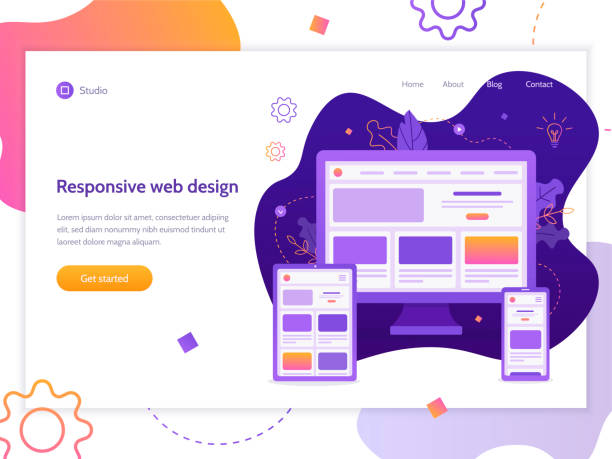Key features to consider for website design and development include
Responsive design is a key feature of website design and development that involves creating a website that can adapt to different screen sizes and devices. This means that the website should be easy to use and navigate on a desktop, laptop, tablet, or smartphone, regardless of the device's screen size. With more and more people accessing the internet from mobile devices, responsive design is essential for ensuring that your website is accessible to a wide audience.
Responsive design involves creating a layout and design that is flexible and fluid, adjusting to the screen size and orientation of the device. This often involves using a grid-based layout and designing with mobile-first in mind. By ensuring that your website is responsive, you can provide a positive user experience for your visitors, regardless of the device they are using. This can also help to improve your website's search engine rankings, as search engines prioritize mobile-friendly websites in their results. Overall, responsive design is an essential feature to consider when designing and developing a website.

User-friendly navigation is a key feature of website design and development that involves creating a menu or structure that is intuitive and easy to use for website visitors. Navigation is essential for helping users find the information they need on your website quickly and easily. A user-friendly navigation system should be clear and concise, using simple language and categories that are easy to understand.
To create a user-friendly navigation system, you should consider the needs of your target audience and the structure of your website. This can involve organizing content into clear categories and subcategories, using dropdown menus or a sidebar menu for easy access, and providing a search bar for users who want to find specific information.
Good navigation can also involve the use of breadcrumbs or a sitemap, which helps users understand where they are on your website and how to get to other pages. User-friendly navigation can also help improve your website's search engine optimization (SEO) by making it easier for search engines to crawl your site and index your pages.
Compelling content is a key feature of website design and development that involves creating high-quality, engaging, and relevant content that attracts and retains website visitors. Good content should be informative, interesting, and written in a tone that matches your brand and target audience. It should also be easy to read, scannable, and include appropriate images, videos, or other multimedia.
Good content can help build trust with your audience, establish your brand as an authority in your industry, and drive traffic and conversions. Compelling content can also improve your website's search engine optimization (SEO), as search engines prioritize high-quality content that provides value to users.
To create a visually appealing website, you should consider the needs and interests of your target audience and the goals of your website. This can involve conducting research and using analytics to understand what design elements are most effective for your audience. It can also involve creating a design that is responsive and optimized for different devices and screen sizes.
A visually appealing website can help establish your brand identity and make your website stand out from competitors. It can also improve user engagement and retention, as users are more likely to stay on a website that is visually appealing and easy to navigate. Additionally, a visually appealing website can help improve your website's search engine optimization (SEO), as search engines prioritize well-designed, user-friendly websites.
SEO (Search Engine Optimization) is the practice of optimizing a website to rank higher on search engine result pages, with the goal of increasing organic traffic to the site. SEO is an important consideration in website design and development, as it can help to improve a website's visibility, attract more visitors, and ultimately increase conversions and revenue.
When designing and developing a website, there are several key SEO factors to consider. These include:
Identifying and targeting relevant keywords that users are searching for can help to improve a website's visibility and attract more organic traffic.
Creating a clear and organized site structure and navigation can make it easier for search engines to crawl and index your site, which can improve its ranking.
Ensuring that your website is mobile-friendly and optimized for different devices is important, as more users are accessing the internet on their mobile devices.
Improving the load time of your website pages can improve the user experience and ranking of your site.
Providing high-quality, relevant, and engaging content on your website can attract more visitors and improve your website's ranking.
Speed and performance are critical considerations in website design and development. A fast and high-performing website can improve the user experience, increase engagement and retention, and ultimately drive more traffic and conversions.To improve the speed and performance of a website, there are several key factors to consider. These include
Optimizing the size and format of images used on your website can significantly improve load times.
Reducing the number of HTTP requests required to load a page can improve its load time and performance.
Caching commonly accessed content and resources can reduce load times and improve the overall performance of a website.
Reducing the size and complexity of code and scripts used on a website can improve its load time and performance.
Selecting a reliable and high-performance web host is critical to ensuring fast load times and good website performance.
Security is a crucial consideration in website design and development. A website that is not secure can leave user data and personal information vulnerable to theft or misuse, and can also damage the reputation of the website and its owners. To ensure the security of a website, there are several key measures that must be taken. These include:
Implementing HTTPS protocol ensures that all data sent between the user and the server is encrypted and secure.
Keeping the website up-to-date and performing regular maintenance checks can help identify and address security vulnerabilities.
Using strong passwords and authentication methods can help prevent unauthorized access to the website and its data.
Regularly backing up website data and having a recovery plan in place can help ensure that the website can be quickly restored in case of a security breach or data loss.
Implementing security tools and plugins can help identify and prevent security vulnerabilities and attacks.
Integrating security into website design and development is an essential step to ensure that the website is secure and protected against potential threats. There are several measures that can be taken to integrate security into web design and development, such as:
The web hosting provider should be reliable, secure, and able to handle website traffic
SSL and HTTPS ensure that all data transmitted between the website and its users is encrypted and secure.
Implementing secure coding practices such as input validation, parameterized queries, and escaping user input can help prevent attacks such as SQL injection and cross-site scripting.
Keeping software and plugins up-to-date helps to patch security vulnerabilities and prevent attacks.
Performing regular security audits and testing can help identify and address security vulnerabilities.
Implementing access controls and user authentication can help prevent unauthorized access to the website and its data.
Our Client
















